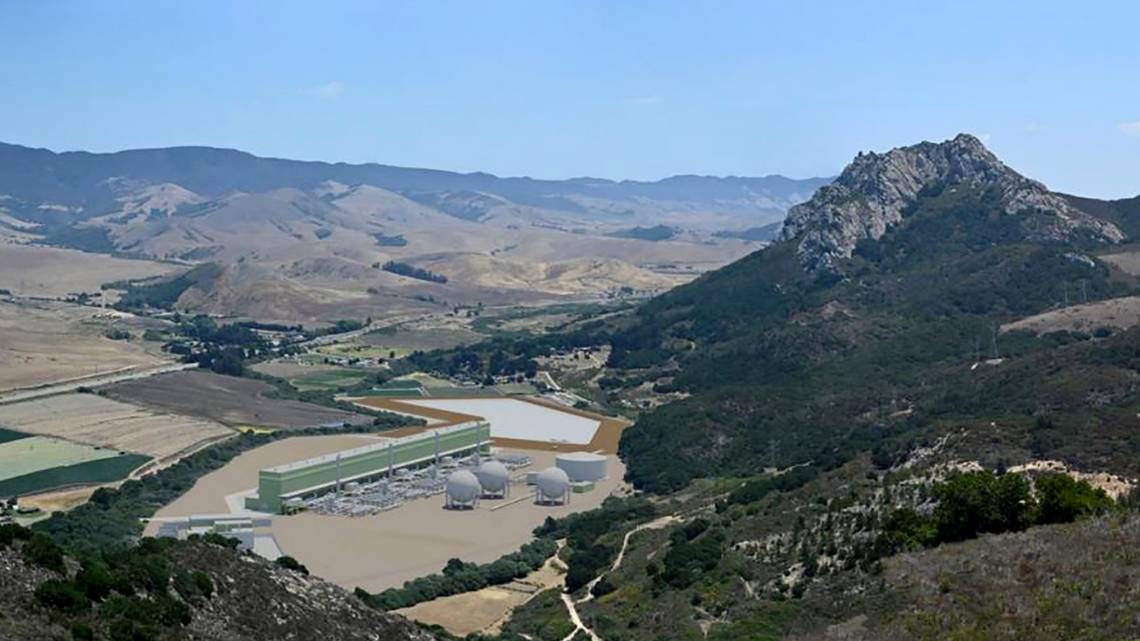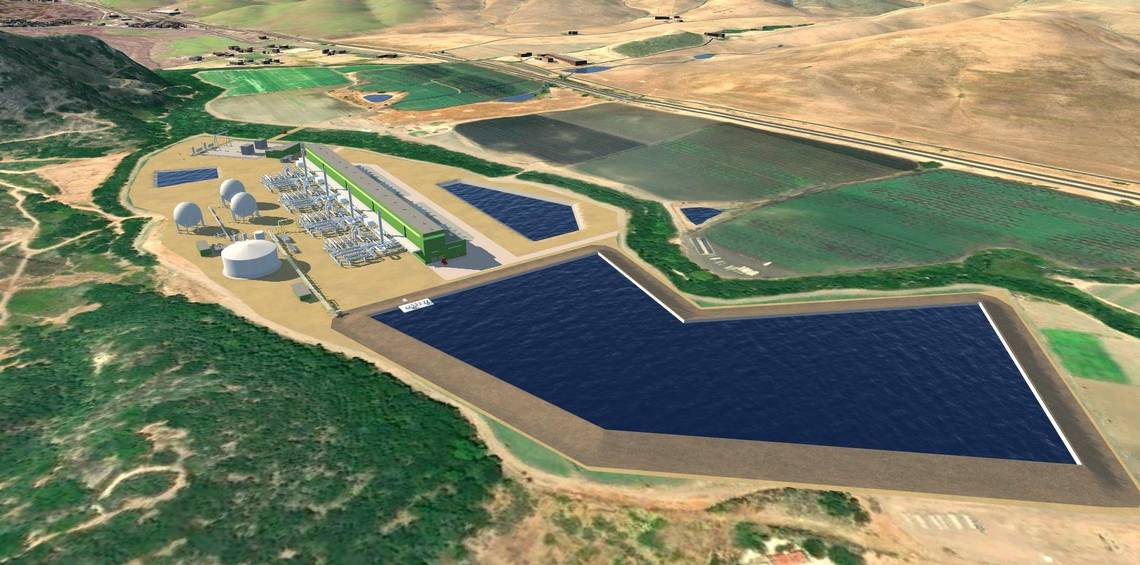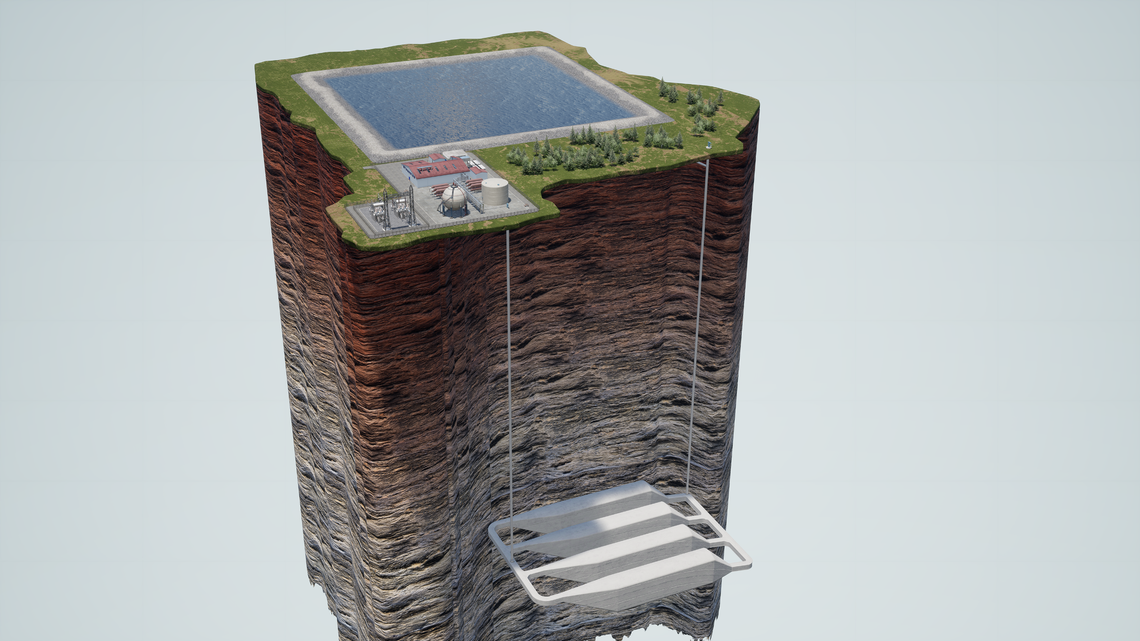|

By
MACKENZIE
SHUMAN
October 10, 2023
Canadian company drops application to build underground energy storage
plant off Hwy. 1

A rendering by Hydrostor shows its
proposed compressed air energy storage plant along Highway 1 at the
base of Hollister Peak. COURTESY OF HYDROSTOR
The Canadian company that wanted to build an
underground energy storage plant along Highway 1 in San Luis Obispo
County has withdrawn its application nearly two years after the
project was proposed. On Friday, the California Energy Commission
terminated the proceeding for energy company Hydrostor’s Pecho Energy
Storage Center. The energy storage center was proposed to be
constructed in the shadow of Hollister Peak on farmland off the scenic
highway between San Luis Obispo and Morro Bay. The site would have
turned 300 acres of farmland into an industrial site to store 400
megawatts of energy by using excess electricity to compress air in
caverns deep underground. Releasing the air would have spun turbines
that would then generate electricity to be sold for use on the grid.
The facility was proposed to include a 100-foot-tall, 65-foot-wide and
1,075-foot-long building housing the power generators and air
compressors, along with many other above-ground structures to
facilitate the unique energy storage method. A 27-acre, 40-foot-deep
water reservoir would have also been located on the proposed site.
Deemed by Hydrostor to be a fossil-fuel-free and efficient way for
storing electricity on the grid, the Pecho Energy Storage Center would
have also helped California meet energy storage and clean electricity
needs.

Hydrostor, a Canadian company, wants to build a
400-megawatt compressed air energy storage plant in San Luis Obispo
County, between Highway 1 and the base of Hollister Peak in the scenic
Chorro Valley. Courtesy of Hydrostor
COASTAL COMMISSION BLOCKS HYDROSTOR TEST
DRILLING
However, the energy storage plant faced
challenges right off the bat. In the notice of withdrawal of its
application, Hydrostor said that “general pre-development data
collection restrictions applied within the coastal zone.” The company
was likely referring to its attempt to survey the project’s proposed
site by drilling monitoring wells deep underground to then scan the
geology and confirm it would be suitable for the compressed air
caverns. Immediately after beginning the drilling work in early 2022,
neighbors complained of the loud noises and bright lights it caused.
The California Coastal Commission then sent a letter to Hydrostor in
February 2022 noting that such drilling work would need permitting
from the state. Hydrostor had only obtained permits from San Luis
Obispo County. Without the state permits, the Coastal Commission
threatened to fine Hydrostor if it continued the drilling work.
Because of this, Hydrostor said in its notice of withdrawal that the
company “has been exploring alternative project configurations to
ensure maximum benefits for the Central Coast electrical grid.”
Hydrostor’s senior vice president of commercial affairs, Curt
Hildebrand, told The Tribune in a statement that the company has not
completely abandoned its idea for a San Luis Obispo County energy
storage project. “Hydrostor is examining options to optimize the site
location,” he wrote in an email. “We continue to explore alternative
options to develop an energy storage resource to serve the Central
Coast community.”

Hydrostor
has proposed building a 400-megawatt compressed air energy storage
plant in San Luis Obispo County. The new technology works by bringing
in excess energy from renewable energy or the grid to then compress
air and store it underground in large caverns. When energy is needed,
the compressed air is then released through a turbine that produces
electricity. Courtesy of Hydrostor
Green Play Ammonia™, Yielder® NFuel Energy.
Spokane, Washington. 99212
509 995 1879 Cell, Pacific Time Zone.
General office: 509-254 6854
4501 East Trent Ave.
Spokane, WA 99212
|